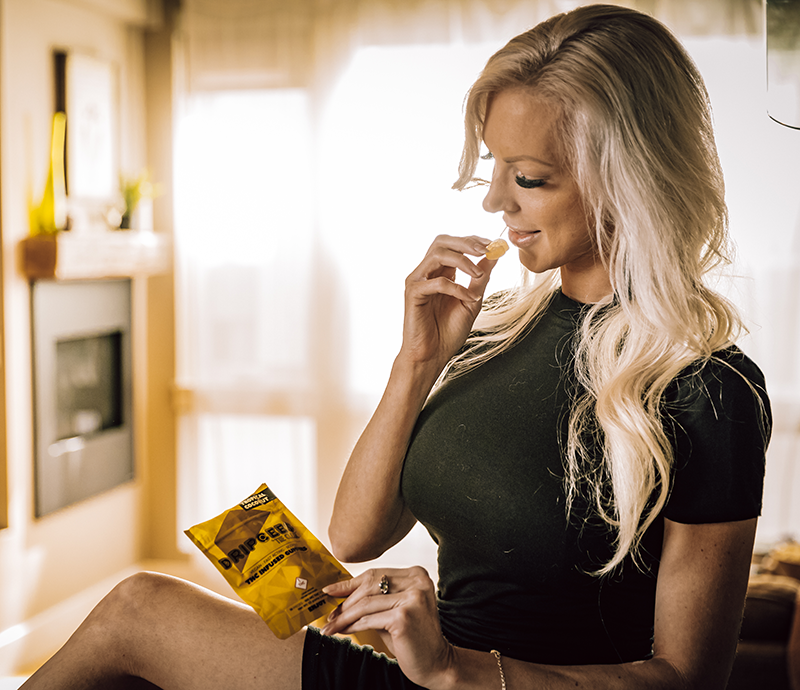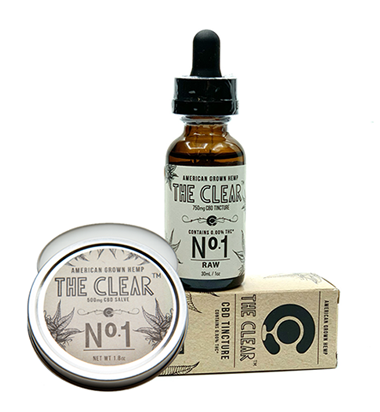Cannabis affects your body based on the ways that you consume the plant’s active substances, or cannabinoids; we call these ways “delivery methods.” The five most common cannabis delivery methods are eating edibles, smoking, vaping, taking tinctures, and using topicals.
Each delivery method can have different effects, and the consumer’s experience can vary from one person to another. But how do you know which method—or methods—is right for you? It often depends on why you’re taking the cannabis (recreational or medical purposes), which cannabinoids (primarily, THC or CBD) you want to take, and what your experience level is.
Consume edibles or smoke?
Most cannabis is either smoked or eaten, but these two methods of consumption are different in many ways. For starters, the THC in cannabis destined to become an edible must first be activated in a process called decarboxylation. This process uses high heat to change the molecular structure of the cannabinoid so it can create the “high” that cannabis is known for. When you smoke flower, this process happens naturally during combustion.
Cannabis ingested in a traditional edible form typically has a delayed but pronounced effect on the body. That’s because the THC must pass through your digestive system and become metabolized in your liver before it becomes available to the receptors in your endocannabinoid system. This process can take up to an hour or more depending on factors such as how recently a person has eaten, making the onset of effects take significantly longer than it usually takes to begin feeling the effects of smoked flower.
However, THC is five times more active when digested than when it is absorbed through the lungs (Simon, 2018). The effects of an edible usually peak after three hours, then begin to wear off gradually, but it can take up to 12 hours for the effects to dissipate completely. The delayed onset of traditional edibles, coupled with their high potency, means that new users should be especially careful when trying them for the first time.
| Method | What | Time to Work | Length of Effects | Pros | Cons |
| Smoking | Burning cannabis flower and smoking it | A few minutes | 2-3 hours | Fast, whole-body effects, stronger effects when used with concentrates | Cannabinoids lost in smoke, burning sensation, long-term health concerns |
| Vaping | Heating cannabis oil and inhaling the vapor | A few minutes | 2-3 hours | Ease of use, less harsh, more concentrated oil | Requires equipment/hardware, some cannabinoids lost in vapor, potent effects can overwhelm new users |
| Traditional Edibles | Eating or drinking cannabis-infused food | 1-2 hours | 4-10 hours | Ease of use, longer lasting effects than smoking | Longer wait, problems with excess dosing, different feeling high |
| Fast-acting Edibles | Eating or drinking cannabis-infused fast-acting food | 15-30 minutes | 4-10 hours | Ease of use, onset of effects is faster, longer lasting effects than smoking | Fast onset of effects may overwhelm new users, may not be as long-lasting as traditional edibles |
| Tinctures | Placing a drop or two of liquid tincture under tongue or in food | 15-45 minutes (longer if used as an edible) | 2-3 hours (longer if used as an edible) | Ease of use, precise dosing, titration | A less-intense high than other methods |
| Topicals | Applying cannabis-infused oil, cream or lotion to skin | A few minutes to a few hours | 1-3 hours | Ease of use, therapeutic and targeted effects, not psychoactive (except for transdermal patch) | Doesn’t produce a high |
Eating Edibles
Cannabis edibles may well be the most versatile infused product on the market. In addition to the more well-known varieties like cookies, and brownies, edibles can encompass a wide range of crave-worthy foods and beverages. Infused pizza sauce, anyone?
Traditional THC edibles can take up to four hours to work (though typically only take 1-2 hours), and fast-acting edibles can take only 15-20 minutes to work. The effects can last four to 10 hours depending on your metabolism. Because of the delay of onset, you shouldn’t eat more than one serving of traditional edibles within two hours until you are comfortable with your tolerance. With fast-acting edibles like DripCees gummies, you don’t have to wait as long to see how it makes you feel.

New customers often find edibles more appealing than smoking but are unaware of how strong they are. And even if you’ve already consumed cannabis before (through smoking, vaping, or another method) and can tolerate that, your tolerance for edibles will still be completely different. So, if you’re a new edible consumer, consider microdosing and start low—with a 10 milligram serving of THC or less—and take it slow. You’ll need only a small dose in the beginning. In any event, eating too many edibles (more than one serving at a time) can cause a panic attack or nausea.
Smoking cannabis flower
The oldest method of delivering cannabis is burning the raw flower and smoking it, usually through a pipe, water pipe (called a bong), joint, infused pre-roll like TWAX, or cigar blunt. Flower comes in a wide variety of strains—predominately sativas, predominately indicas, or hybrids—that produce different effects on the brain: a full-body state of exhilaration, relaxation, or anywhere in between, and a potential for temporary relief from discomfort. The effects begin in as little as a few minutes and last two to three hours.
Smoking isn’t the most efficient in terms of delivering cannabinoids to the body. Some estimates put the THC lost in smoke at about 60 percent, compared to about 40 percent lost through vaping.

CBD and THC Vaping
Vaporizing, or vaping, cannabis provides the advantages of smoking flower without the toxins that come with it. Vapes also allow you to customize your experience by containing a wide range of concentrates, ranging from purified THC or CBD oil to broad-spectrum and terpene-rich formulations.
Unlike joints or blunts, vaporizers don’t heat the cannabis to the point of combustion. Instead, they only provide enough heat to vaporize the cannabinoids. When inhaled, this vapor delivers concentrated cannabinoids straight to your bloodstream by way of your lungs’ alveoli. The effects often take hold within 10 minutes of the first draw, and they begin to dissipate between 30 and 60 minutes later.
Vaping also makes it easy to consume specific amounts of THC, CBD, or other cannabinoids. You can control your preferred amount by taking a small draw, waiting a few minutes, and seeing how you feel. The ability to control your cannabinoid intake coupled with its early onset makes vaping a preferable option for the canna-curious.
While researchers aren’t ready to declare vaping as a healthy or safe alternative to smoking, the evidence does suggest that vaping exposes you to fewer toxins than smoking does. One of the earlier studies comparing smoking to vaping found that vaporized cannabis contained far fewer carcinogens than cannabis smoke did. (Gieringer, St. Laurent & Goodrich, 2004).

A subsequent study found that while switching from smoking to vaping yields “only relatively modest respiratory health benefits” in most cases, the study supported the idea that medical cannabis patients who suffer from respiratory or pulmonary problems could benefit significantly from vaping cannabis instead of smoking it (Tashkin, 2015).
More recent studies have shown that “compared with smoking, vaping cannabis can reduce: exposure to several toxins, CO, and chronic respiratory symptoms while producing similar subjective effects, and hence might have the potential of harm reduction among habitual cannabis smokers” (Chaiton, et. al 2021).
Yet, it’s not just cannabis smoke you should worry about. An outbreak of vape-related illnesses in 2019 shed light on the dangers inherent in some of the additives used in vape oil. These include:
-
- *Propylene glycol (PG),
-
- *Vegetable glycerin (VG),
-
- *Polyethylene glycol 400 (PEG 400) and
-
- *Medium chain triglycerides (MCT)
-
- *Vitamin E acetate (also known as alpha-tocophyeryl acetate and tocopherol acetate)
A study published in 2017 found that heating PEG 400 and PG caused them to release high levels of acetaldehyde and formaldehyde, both of which are considered to be carcinogens. PEG 400 proved to be particularly noxious; when vaporized, a single inhale of this substance contains nearly as much formaldehyde as smoking an entire cigarette (Troutt & DiDonato, 2017). In 2019, an investigation by the U.S. Centers for Disease Control and Prevention identified vitamin E acetate, an additive found in many black-market vape products, as a cause behind an outbreak of vape-related illnesses that year (Steenhuysen, 2019).
To avoid the risk, make sure your vape is made and sold by a state-licensed facility. Read the packaging carefully to see if the manufacturer used any additives in the vape oil, then do a little research to see if these additives are known to cause harm.
When in doubt, ask the budtender at your licensed dispensary; they’ll be able to help you find a reputable and trustworthy brand. Finally, never buy vape products off the street or online; there’s a very good chance these are black-market products. If you need tips for vaping, check out these recommendations to get the most out of your The Clear vape pen or cartridge.
Concentrates can also be vaporized, in a process known as “dabbing.” Concentrates are extractions of the cannabis plant and are typically created with propane, CO2, butane, alcohol or heat. But concentrates are much stronger than flower. They can contain 60% or higher concentrations of THC and are extremely potent.
THC and CBD Tinctures
Compared to edibles, tinctures give you more control over how much cannabis you consume and how soon you feel its effects. This liquid-based delivery method allows you to gradually increase the amount, a drop at a time until you achieve the desired effects. When taken under the tongue, the effects typically onset quicker than in traditional edibles. For these reasons, tinctures are a better choice for customers who are new to cannabis.
Tinctures can be consumed in three ways: Under the tongue (sublingually), swallowed by themselves, or added to foods. Using the sublingual method allows the tincture to absorb directly into the bloodstream via arteries under the tongue (Pirschel, 2018). As a result, you’ll feel the results faster than if you swallow it or use it to infuse food. Expect to begin feeling the effects of a sublingual tincture within 15 to 45 minutes.
If you’re new to cannabis, start with a drop or two and wait until you notice the effects or a full 45 minutes have passed. Then, add a drop or two more. This method of gradually increasing the quantity in discreet amounts is called titration, and it will help you achieve your ideal high without overdoing it. If you choose to ingest the tincture orally, either by itself or in a food, expect to wait for two hours or more to feel the effects. This method of using tinctures lends itself to a wide range of home-infused drinks and recipes, including shakes, sauces, and baked goods.

THC and CBD Topicals
Topicals include a wide range of products like balms, creams, lotions, and body oils. They’re often designed to provide localized, non-psychoactive effects. They often contain CBD, THC, or a combination of both. In addition to cannabinoids, some topicals may include terpenes from other plants, like peppermint, to complement the relief these products are designed to create.
So, will a topical get you high? The simple answer is, generally, no. The skin is an effective barrier that protects your body from all manner of potential threats from the outside. So, if you apply most topicals that are rich in THC, the skin will prevent the cannabinoid from entering your bloodstream and giving you a high.
Transdermal products are a different story. These are specially designed to carry cannabinoids across the skin and into the blood. If a smoke-free high is what you’re looking for, transdermals can be a simple yet effective option.
“The time it takes for a topical to take effect depends largely on what’s in it,” said Courtney Maltais, botanist and one of the founders of The Clear™. Several factors influence a topical’s bioavailability or the rate at which it’s absorbed and made available to the body. Products that use a carrier oil that easily absorbs into the skin will generally work faster than those that don’t. It’s difficult to assign a set timeframe for when a topical will become bioavailable. Still, anecdotal evidence shows that at least some topicals are fast-acting.
Patients who used The Clear’s CBD salve usually began to feel the effects within five minutes of application, Maltais said. A small study published in 2017 showed similar results. In it, three patients with rare but painful skin ulcers applied a topical containing nearly equal amounts of THC and CBD. The study participants reported feeling pain relief within three to five minutes. (Kiefer, 2017). Maltais estimated that the longest it might take to feel the effects of a topical could be 15 or 20 minutes.
Early research into the effectiveness of cannabis topicals has yielded some promising results.
-
- *In the 2017 study, two of the three patients reported that the relieving effects of the topical was effective enough to allow them to significantly reduce their average daily morphine intake.
-
- *Another study found that CBD oil significantly reduced the discomfort and unpleasant sensations caused by peripheral neuropathy, a condition caused by nerve damage to the brain and spinal cord (Xu, Cullen, Tang, et al., 2019).
Researchers caution, though, that more research is needed to fully understand the potential of cannabis-infused topicals.
References
Ren M., Tang Z., Wu X., Spengler, R., Jiang, H., Yang, Y., Boivin, N. (2019). The Origins of Cannabis Smoking: Chemical Residue Evidence from the First Millennium BCE in the Pamirs. Science Advances, 5(6). doi:10.1126/sciadv.aaw1391
McInnis, O., Plecas, D. (2016). Clearing the Smoke on Cannabis: Respiratory Effects of Cannabis Smoking — An Update. Retrieved from https://www.ccsa.ca/sites/default/files/2019-04/CCSA-Cannabis-Use-Respiratory-Effects-Report-2016-en.pdf
Tully, C.F. (2019). A global history of cannabis edibles. Leafly. Retrieved from https://www.leafly.com/news/lifestyle/canada-world-history-cannabis-edibles
Simon, M. (Nov 6 2018). “THC! CBD! Terpenoids! Cannabis Science is Getting Hairy.” Wired Magazine. Retrieved from https://www.wired.com/story/cannabis-science-entourage-effect/
Monte AA, Shelton SK, Mills E, et al. (2019). Acute Illness Associated With Cannabis Use, by Route of Exposure: An Observational Study. Ann Intern Med. 2019;170:531–537. [Epub ahead of print]. doi: https://doi.org/10.7326/M18-2809
Pirschel, C. (2018). What routes of administration are available for medicinal cannabis? ONS Voice, 33(1), 23. Retrieved from http://proxy.lib.wy.us/login?url=https://search-proquest-com.proxy.lib.wy.us/docview/2133342007?accountid=29653
Hanna, A. (2018). Cannabis tinctures: Everything you need to know. High Times. Retrieved from https://hightimes.com/guides/cannabis-tinctures/.
Pahr, K. (2019). How long does it take for CBD oil to work? How fast-acting is CBD? Ministry of Hemp. Retrieved from https://ministryofhemp.com/blog/how-long-cbd-to-work/
Kiefer, D. (2017). Topical cannabis for wound pain: A case series. Integrative Medicine Alert, 20(12) Retrieved from http://proxy.lib.wy.us/login?url=https://search-proquest-com.proxy.lib.wy.us/docview/1978189964?accountid=29653
(2017). Cannabis balms are the bomb. BDS Analytics. Retrieved from https://bdsanalytics.com/balms/
Gieringer, D., St. Laurent, J., Goodrich, S. (2004). Cannabis Vaporizer Combines Efficient Delivery of THC with Effective Suppression of Pyrolytic Compounds. Journal of Cannabis Therapeutics, 4 (1). Doi: 10.1300/J175v04n01_02
Tashkin, D.P. (2015). How Beneficial is Vaping Cannabis to Respiratory Health Compared to Smoking Addiction, 110 (11), 1706-1707. DOI:10.1111/add.13075
Troutt, W. D., & DiDonato, M. D. (2017). Carbonyl compounds produced by vaporizing cannabis oil thinning agents. Journal of Alternative and Complementary Medicine, 23(11), 879-884. doi:http://dx.doi.org/10.1089/acm.2016.0337
Steenhuysen, J. (2019, November). U.S. CDC reports ‘breakthrough’ in vaping lung injury probe as cases top 2,000. Reuters. Retrieved from https://www.reuters.com/article/us-health-vaping-cdc/u-s-cdc-reports-breakthrough-in-vaping-lung-injury-probe-as-cases-top-2000-idUSKBN1XI26R
White, A. (2018, December). Plans for the first e-cigarette went up in smoke 50 years ago. Smithsonian Magazine. Retrieved from https://www.smithsonianmag.com/innovation/plans-for-first-e-cigarette-went-up-in-smoke-50-years-ago-180970730/.
Chaiton, Michael, (2021). Are vaporizers a lower-risk alternative to smoking cannabis?
National Library of Medicine. Retrieved from: https://www.ncbi.nlm.nih.gov/pmc/articles/PMC8975973/C

